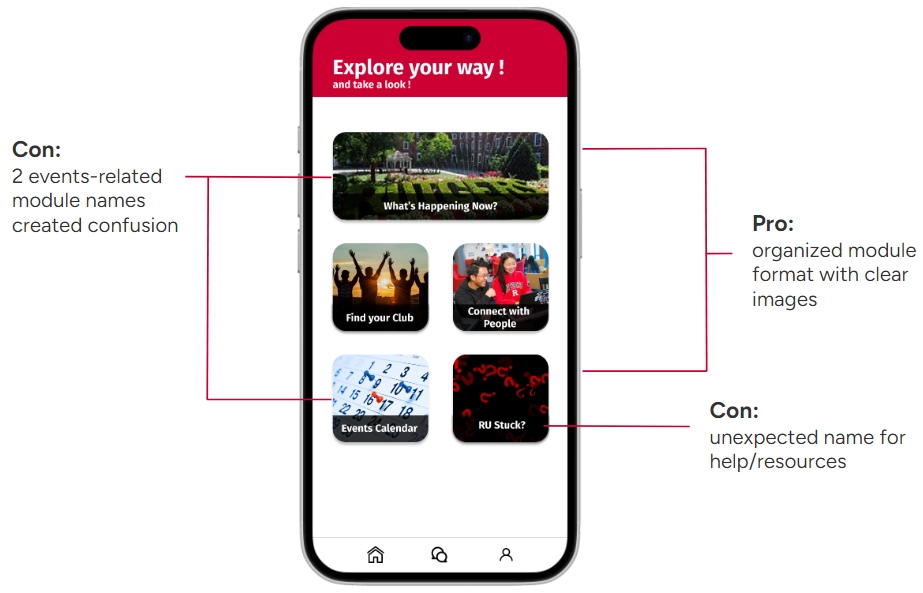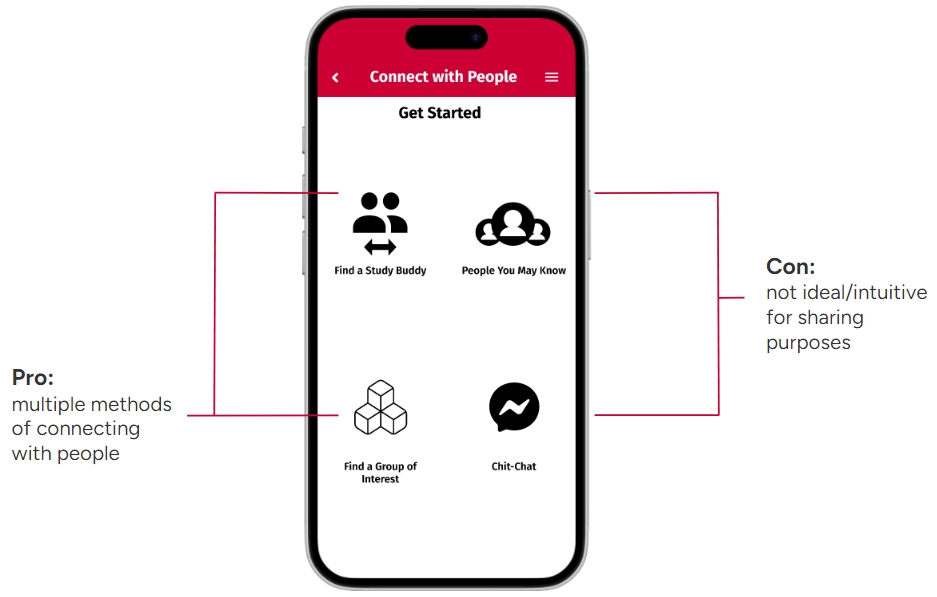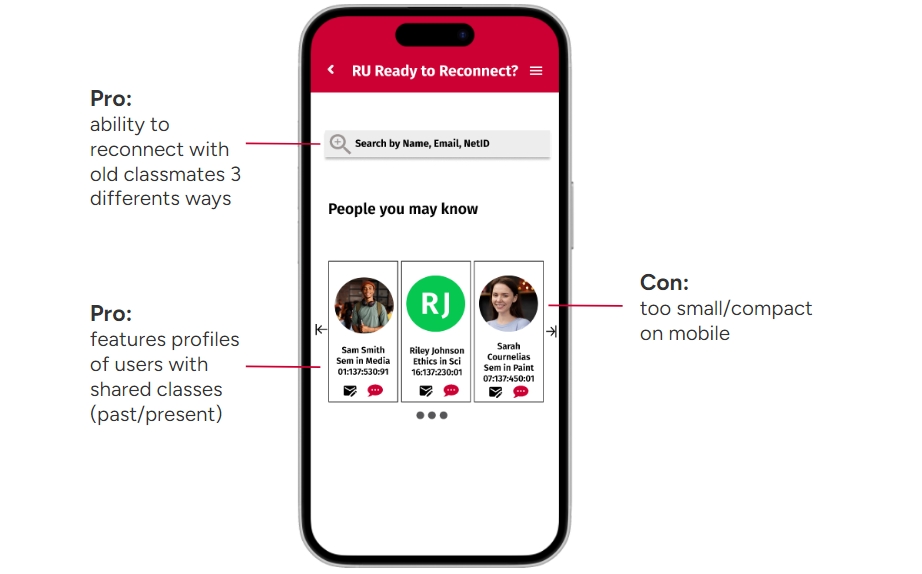Enhancing Student Engagement and Collaboration at Rutgers University
- abhilasha salunia
- Nov 9, 2024
- 7 min read
Updated: 11 hours ago
Fictional Problem Statement
As Rutgers University faces growing societal polarization, there is a need for a digital solution that encourages collaboration, inclusivity, and community building among students. The university seeks to address these challenges by creating an interactive mobile application designed to foster connections, support diverse interests, and enhance collaboration across disciplines. This solution aims to create a more engaged and cohesive university environment, where all members can feel supported and participate in enriching and respectful dialogues. Through user-centered design practices, the project will uncover the needs, preferences, and behaviors of the university community to develop a prototype that enhances student engagement and builds a stronger sense of belonging on campus.
TEAM SIZE 6 people | TIMELINE 4 days |
Tools Used: Figma, FigJam, Miro, Google Forms
Primary Design Goals
Foster Community: Create opportunities for students to meet, collaborate, and build relationships outside of the classroom
Enhance Collaboration: Provide tools for students to easily find study groups, project partners, and skill-sharing opportunities
Support Diverse Interests: Cater to a wide range of extracurricular activities and academic disciplines, ensuring inclusivity
Field Research
To better understand student engagement and community involvement at Rutgers, we conducted a survey of 48 students, including both undergraduates and graduates, across campus. Our research focused on gathering demographic insights and exploring how students connect with clubs and activities, maintain relationships with classmates and friends, and feel about the time they spend engaging with others.
Our goal was to uncover current levels of involvement and collaboration among students, identify factors influencing their community engagement, and assess their satisfaction with social interactions. Below are the key insights from our findings:
ONLINE COMMUNICATION | ACEDEMIC & PROFESSIONAL FOCUS |
All students interviewed use social media platforms or online communication tools to stay connected with friends and classmates | 26% of students attend and prioritize professional development clubs and events over social activities, reflecting a strong focus on academic and career-related growth |
DIFFICULTY KEEPING CONNECTIONS | INTEREST GROUPS |
Most students, particularly commuters, struggle to maintain relationships outside of classes and clubs, often relying on friendships formed at the start of their college experience | 79% of students are active in clubs and organizations aligned with their personal interests, with most discovering groups through annual involvement fairs or recommendations from friends |
Standout Responses
How did you find out about the clubs you are involved in?
“I signed up for RU Breaks during the involvement fair my freshman year, but I actually didn't know Rutgers had a pickleball club until my junior year when my friend told me about it...I never saw their table at the involvement fairs—it's impossible to catch every club in such a huge crowd—but I wish I knew about [the pickleball club] earlier because I fell in love with it and the people”
How do you feel about the amount of time you interact with others, such as friends or classmates?
“At the start of the semester it's always a lot easier to meet up with friends and maybe grab a bite or chat, but once we get busy with classes, it becomes a lot harder. Ideally, it would be nice to study with people taking the same classes as me so we can be productive while also socializing, but I haven't really been able to get a group together yet.”
Personas & Journey Map
As we created our personas, we took into consideration:
Field Research: identifying the needs and experiences of real students
Our Goal: to create a usable, desirable, and intuitive product
As we built our journey map, we brainstormed by:
Grouping the users’ behaviors from the beginning to the end of the semester
tap to expand

tap to expand
Design Studio
Kickstarting the design process with a large team can be challenging, given the diverse ideas and numerous possibilities. We used the 6-8-5 approach, which involves generating 6-8 concept sketches on an 8-up grid in 5 minutes. This method allows us to:
Accelerate the ideation phase, helping us quickly move towards prototyping and initial user testing
Provide each team member an opportunity to share their ideas and hear the rest of the team's thoughts
Combine everyone's initial concepts to refine and develop a few standout ideas, fostering alignment on a direction for the initial prototype
We conducted three with our team of six: the first focused on individual designs, the second in two groups of three, and the third as a full team. Each round built upon the best ideas from the previous, progressively enhancing and strengthening our vision for the final prototype.
Feature Solutions for Problem Spaces
Feature Solutions for Problem Spaces
Based on insights from our field research, brainstorming sessions, and careful consideration of user personas and journey maps, we identified key areas where students at Rutgers University would benefit from a centralized app. This app would enable students to build and maintain meaningful connections, discover personalized activities, support their academic growth, and access essential student resources—all in one seamless platform.
Maintain Connections: The app facilitates connections beyond the classroom by offering tools to share upcoming events, invite peers to join study groups, and network through shared classes and interests.
By creating a space specifically for finding and sharing events, students may feel more comfortable inviting others to participate, fostering stronger relationships on campus.
tap to expand
Discover Personalized Activities: With the Who RU? survey completed during profile setup, students receive a customized feed of on-campus events and activities tailored to their interests.
Personalizing recommendations encourages students to engage in activities that align with their passions, increasing participation in campus life.
tap to expand
Foster Academic Success: Students can use the app to connect with study buddies or groups and access tutoring resources, combining academic focus with peer interaction.
Field research revealed that many students prioritize academics but struggle to build connections on campus. This feature allows them to maintain their academic focus while socializing with peers who share similar goals.
Access Resources: The app consolidates vital resources—including campus navigation, health and wellness services, tutoring, and career-building tools—into a single, easily accessible hub.
Many students reported being unaware of services like Penji tutoring or Handshake. Centralizing these resources increases awareness and accessibility, ensuring students can take full advantage of Rutgers' offerings.

tap to expand
User Testing
Given our one-day timeframe for high-fidelity prototyping, we prioritized the most essential features for initial user testing, including the homepage, sharing functionalities, and the "People You May Know" feature. We conducted testing with six participants, guiding them through realistic scenarios a typical user might encounter, such as discovering an event of interest and sharing it with a friend. Throughout the process, we recorded their thoughts and choices while navigating the app. The goals of user testing were to:
Identify user pain points and areas of friction
Collect user suggestions and actionable feedback
Gather insights to improve navigation and experience in the future
Here is some of the major feedback we received for three critical pages: Home, Connect with People, and People You May Know:
Visual Design

Explore the Working Prototype
Note: This is not yet a fully functional prototype. Due to time constraints, we prioritized the components most critical for initial user testing.
Takeaways
Research Methods I learned that surveys and in-person field interviews each have unique strengths. For past projects, surveys have allowed me to gather a larger sample size in a shorter time frame, providing quantitative data. In contrast, in-person interviews conducted for this project offered richer, qualitative insights, as participants were more willing to share detailed responses, leading to a deeper understanding of user needs and experiences. | Refining Research Questions It’s important to evaluate the effectiveness of contextual inquiry questions early in the process. Sometimes, revising questions after initial interviews can significantly improve data quality. For example, shifting from "How often do you hang out/study with friends or classmates?" (quantitative) to "How do you feel about the amount of time you interact with others, such as friends or classmates?" (qualitative) helped us uncover deeper emotional insights while still occasionally yielding quantitative data. | "Crazy 8s" and Rapid Prototyping Rapid ideation through the 6-8-5 activity allowed all team members to contribute ideas and transition quickly to prototyping, even with a short timeframe. Early-stage prototypes tested with users revealed potential design challenges, offering a realistic perspective on how users interact with the design. This approach made it easier to address issues before they became ingrained in the final product. |
Things I Would Have Done Differently
Broader User Demographics We could have expanded our participant pool to include a more diverse range of students, such as part-time and master's students, to gain additional perspectives on campus needs. This would help ensure the app caters to the entire Rutgers community, not just traditional, full-time students. | Improve "Who RU?" Survey Questions The survey is meant to generate a personalized feed of clubs and upcoming events on campus. However, upon reflection, we could have developed more targeted and thoughtful survey questions to create a more personalized app experience and improve students' on-campus engagement. By designing questions that better capture students' unique interests, preferences, and needs, our app would be able to provide more accurate recommendations for clubs, events, and resources that resonate with users. | Prototype "Find a Study Buddy" Feature We could have prioritized developing a prototype for the 'Find a Study Buddy' feature earlier in the process to evaluate its usability and relevance during the first round of user testing. Because the Rutgers population is so diverse with many areas of study, the study buddy feature would likely take more time to refine, so introducing a preliminary prototype sooner would have allowed us to address potential challenges earlier. |
Next Steps
This prototype represents an initial concept that requires further refinement through multiple iterations of user testing as features are added and adjusted. If this were a real app development project, our next phase would involve conducting a thorough heuristic evaluation, incorporating feedback and insights from the first round of user testing to identify usability issues and prioritize improvements.
Following this evaluation, we would align agile development cycles with UX sprints for collaboration between design and development teams. This approach would allow for continuous refinement of the app, incorporating iterative feedback and expanding features based on user needs and preferences. Future rounds of testing would focus on validating new functionalities, such as the "Find a Study Buddy" feature, while maintaining a user-centered design process to ensure the app continues to meet the diverse needs of Rutgers students.





























Comments